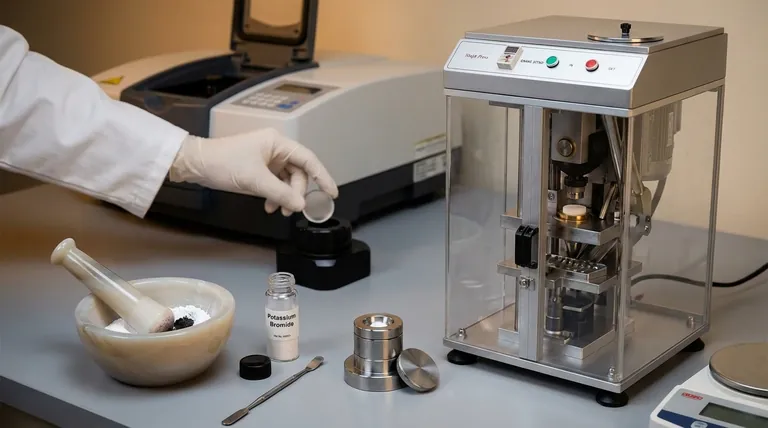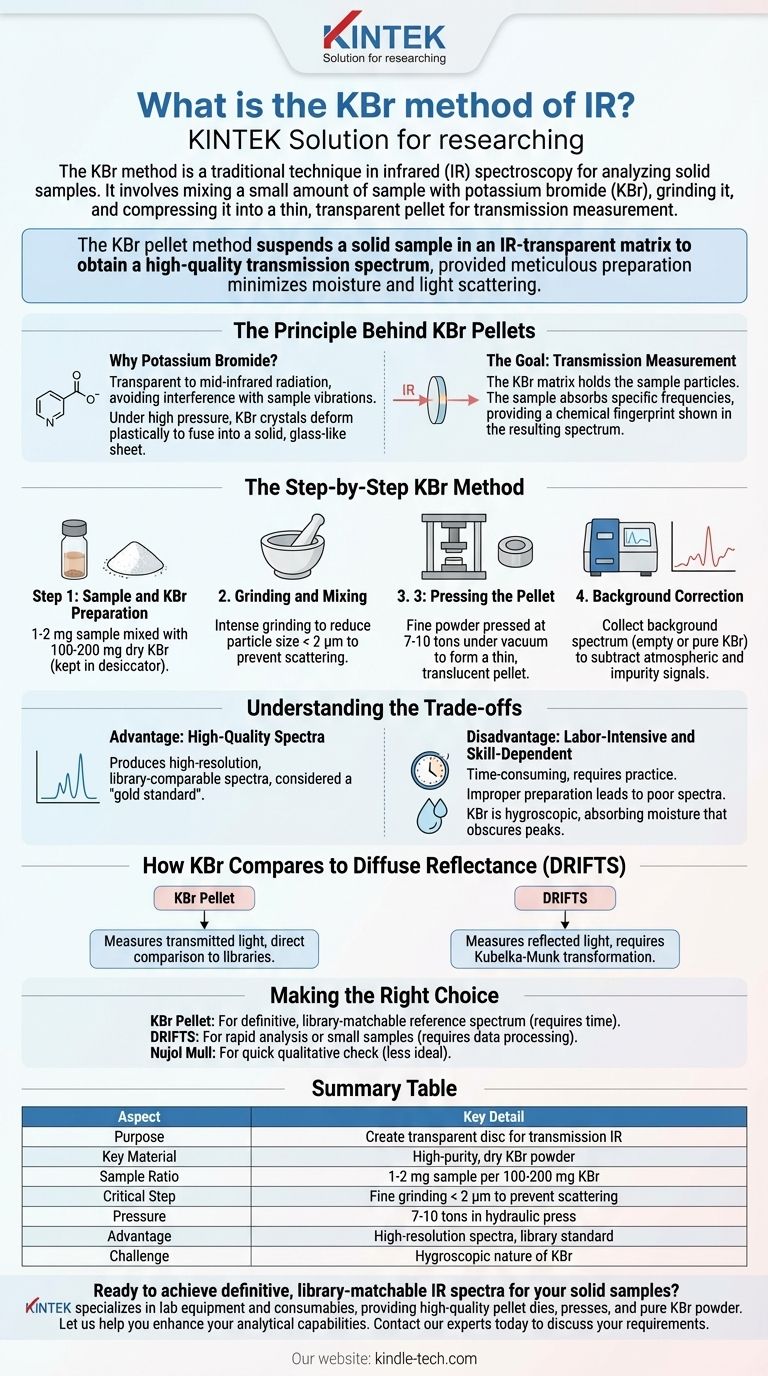En la espectroscopía infrarroja (IR), el método KBr es una técnica tradicional y altamente efectiva para analizar muestras sólidas. Implica mezclar íntimamente una pequeña cantidad de la muestra con polvo de bromuro de potasio (KBr) de alta pureza, moler la mezcla finamente y luego comprimirla bajo alta presión para formar un disco o "pastilla" delgada y transparente. Esta pastilla sirve como una ventana de estado sólido a través de la cual puede pasar el haz de IR, permitiendo una medición clara por transmisión.
El propósito central del método de pastilla de KBr es suspender una muestra sólida en una matriz transparente al IR, lo que permite la adquisición de un espectro de transmisión de alta calidad. Sin embargo, su éxito depende críticamente de una preparación meticulosa de la muestra para eliminar la humedad y los efectos de dispersión de la luz.

El Principio Detrás de las Pastillas de KBr
¿Por qué Bromuro de Potasio?
El bromuro de potasio (KBr) es una sal de haluro alcalino con dos propiedades críticas para la espectroscopía IR. Primero, es transparente a la radiación infrarroja media, lo que significa que no absorbe luz en la región donde la mayoría de los compuestos orgánicos e inorgánicos tienen sus vibraciones características.
En segundo lugar, bajo alta presión, los cristales de KBr se deforman plásticamente. Esto permite que el polvo se fusione en una lámina sólida similar al vidrio que fija las partículas de muestra dispersas en su lugar.
El Objetivo: Medición por Transmisión
El objetivo final es medir la luz que pasa a través de la muestra. La matriz de KBr mantiene las partículas de muestra finamente molidas en el camino del haz de IR del espectrómetro.
A medida que el haz pasa, las moléculas de la muestra absorben energía en frecuencias específicas correspondientes a sus modos vibracionales. El espectro resultante muestra estas absorciones, proporcionando una "huella dactilar" química de la sustancia.
El Método KBr Paso a Paso
Preparación de la Muestra y el KBr
El proceso comienza con una cantidad muy pequeña de muestra, típicamente solo 1-2 miligramos, mezclada con unos 100-200 miligramos de polvo de KBr seco de grado espectroscópico. El KBr debe mantenerse en un desecador u horno de secado para evitar la absorción de humedad.
Molienda y Mezcla
Este es el paso más crítico. La muestra y el KBr se muelen intensamente juntos, generalmente con un mortero y pistilo de ágata, para reducir el tamaño de partícula de la muestra.
Las partículas deben ser más pequeñas que la longitud de onda de la luz IR (menos de ~2 µm) para prevenir la dispersión, lo que puede causar una línea de base inclinada y picos distorsionados en el espectro final.
Prensado de la Pastilla
La mezcla de polvo fino se transfiere a un troquel para pastillas. El troquel se coloca al vacío para eliminar el aire atrapado y la humedad, que de otro modo interferirían con la medición.
Luego se utiliza una prensa hidráulica para aplicar una presión inmensa (típicamente de 7 a 10 toneladas) al troquel, comprimiendo el polvo en una pastilla delgada y translúcida.
Corrección de Fondo
Antes de analizar la muestra, se recopila un espectro de fondo. Esto se puede hacer con un portamuestras vacío o, idealmente, con una pastilla hecha de KBr puro.
Este paso permite que el software del instrumento reste cualquier señal interferente del vapor de agua atmosférico, el dióxido de carbono o impurezas menores dentro del propio KBr.
Comprender las Compensaciones
Ventaja: Espectros de Alta Calidad
Cuando se realiza correctamente, el método KBr produce espectros de transmisión con alta resolución y una línea de base plana. Estos espectros se consideran un "estándar de oro" y son directamente comparables con vastas bibliotecas espectrales comerciales y académicas.
Desventaja: Requiere Mucho Trabajo y Depende de la Habilidad
El proceso de moler, mezclar y prensar requiere mucho tiempo y práctica para dominarlo. Una pastilla mal hecha puede generar espectros de mala calidad e ininterpretables.
El Problema de la Humedad
El KBr es higroscópico, lo que significa que absorbe fácilmente agua de la atmósfera. Esta es la fuente de error más común.
El agua absorbida crea picos amplios y distintos en el espectro IR (alrededor de 3400 cm⁻¹ y 1640 cm⁻¹) que pueden oscurecer o confundirse con los picos de la muestra, particularmente las bandas de estiramiento O-H y N-H.
Cómo se Compara el KBr con la Reflectancia Difusa
El método de reflectancia difusa (DRIFTS) es una alternativa común que a menudo es más rápida, ya que no requiere prensar una pastilla. También es mejor para analizar cantidades de muestra muy pequeñas.
Sin embargo, DRIFTS mide la luz reflejada, no la luz transmitida. El espectro resultante debe convertirse matemáticamente utilizando la transformación de Kubelka-Munk para que se parezca a un espectro de absorbancia estándar, lo que añade una capa de procesamiento de datos.
Tomar la Decisión Correcta para su Objetivo
Seleccionar la técnica de preparación de muestras correcta es fundamental para obtener buenos datos espectroscópicos.
- Si su enfoque principal es obtener un espectro de referencia definitivo y comparable con bibliotecas: El método de pastilla de KBr es la opción superior, siempre que invierta tiempo en una preparación meticulosa.
- Si su enfoque principal es el análisis rápido o tiene una cantidad muy pequeña de muestra: Considere el método de Reflectancia Difusa (DRIFTS) por su velocidad y sensibilidad, pero prepárese para aplicar las transformaciones de datos necesarias.
- Si su enfoque principal es una verificación cualitativa rápida con un equipo mínimo: Una suspensión de Nujol (suspender la muestra en aceite mineral) es una alternativa viable, aunque a menudo menos ideal.
En última instancia, comprender los principios y las trampas de cada técnica le permite generar los datos más precisos y confiables para sus necesidades analíticas.
Tabla Resumen:
| Aspecto | Detalle Clave |
|---|---|
| Propósito | Crear un disco transparente para la medición IR por transmisión de sólidos. |
| Material Clave | Polvo de Bromuro de Potasio (KBr) seco y de alta pureza. |
| Proporción de Muestra | 1-2 mg de muestra por 100-200 mg de KBr. |
| Paso Crítico | Molienda fina a un tamaño de partícula < 2 µm para evitar la dispersión de la luz. |
| Presión para la Pastilla | 7-10 toneladas en una prensa hidráulica. |
| Ventaja Principal | Produce espectros de alta resolución comparables con los estándares de biblioteca. |
| Desafío Principal | La naturaleza higroscópica del KBr requiere un control cuidadoso de la humedad. |
¿Listo para obtener espectros IR definitivos y comparables con bibliotecas para sus muestras sólidas?
El método de pastilla de KBr es un estándar de oro, pero su éxito depende de la técnica adecuada y del equipo confiable. KINTEK se especializa en equipos de laboratorio y consumibles, sirviendo a las necesidades del laboratorio con troqueles para pastillas, prensas y polvo de KBr puro de alta calidad para garantizar que la preparación de su muestra sea precisa y libre de humedad.
Permítanos ayudarle a mejorar sus capacidades analíticas. Contacte a nuestros expertos hoy para discutir sus requisitos de espectroscopía IR y descubrir las soluciones adecuadas para su laboratorio.
Guía Visual

Productos relacionados
- Máquina Prensadora Eléctrica de Tabletas de un Solo Punzón Prensa TDP para Polvo de Laboratorio
- Prensa de pastillas KBR 2t
- Prensa Hidráulica Automática de Laboratorio para Prensa de Pastillas XRF y KBR
- Prensa Eléctrica de Laboratorio Hidráulica Dividida para Pastillas
- Prensa Hidráulica de Laboratorio para Pellets para Aplicaciones de Laboratorio XRF KBR FTIR
La gente también pregunta
- ¿Cuáles son las ventajas de la operación de embutición (prensa)? Desbloquee la producción en masa de alta velocidad y bajo costo
- ¿Cuáles son las diferentes partes de una máquina de tabletas de un solo punzón? Los componentes principales explicados
- ¿Qué es la compresión de tabletas en la industria farmacéutica? El proceso central para producir formas farmacéuticas orales sólidas
- ¿Qué es la técnica de pastilla prensada? Una guía para crear muestras sólidas uniformes a partir de polvo
- ¿Cuáles son las ventajas de la máquina de compresión de tabletas de un solo punzón? Maximice la eficiencia de I+D con un material mínimo



















